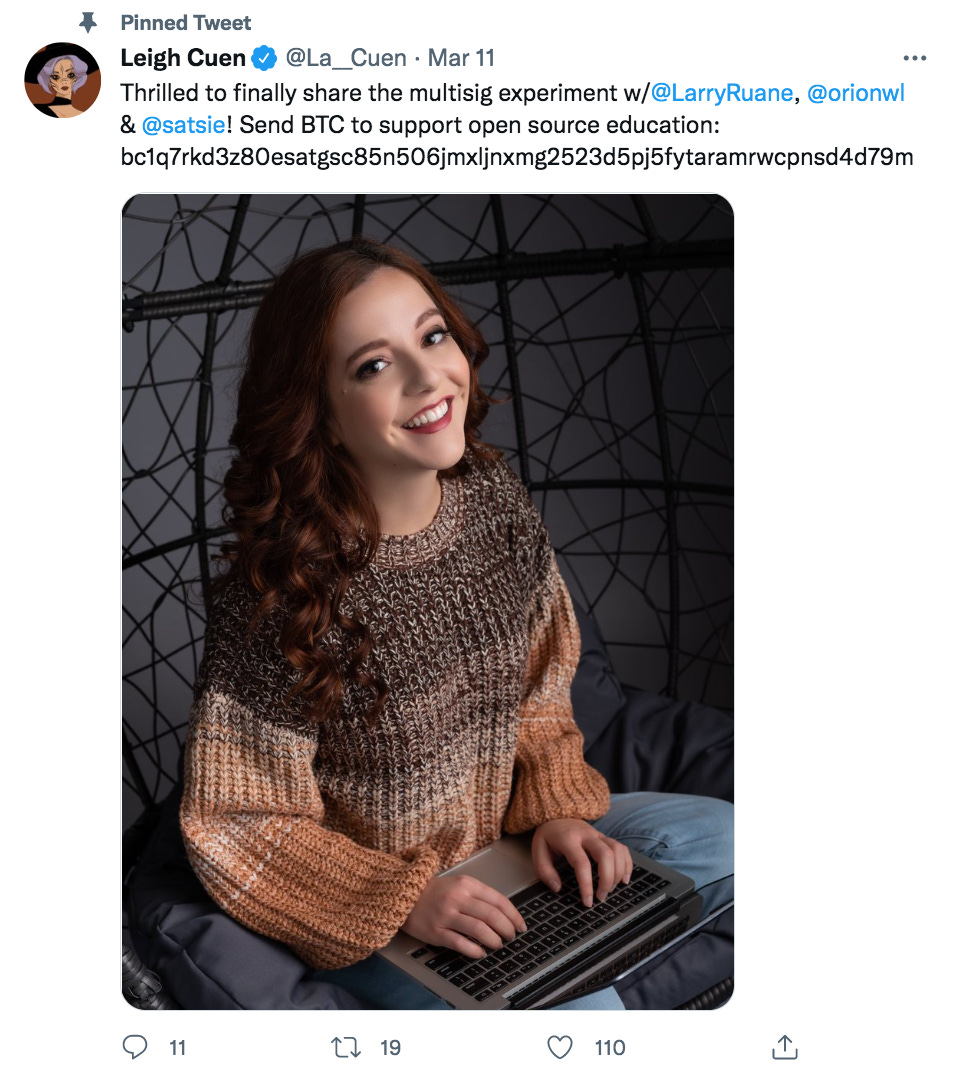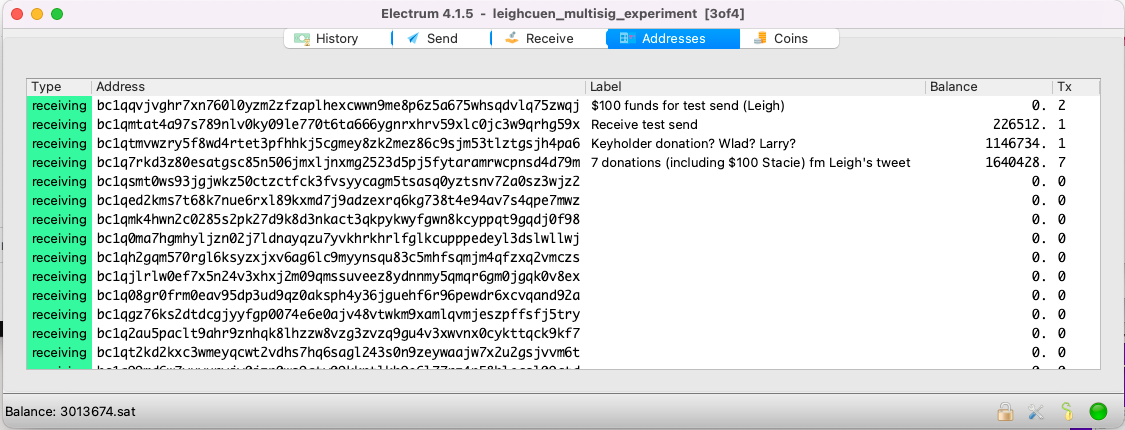Hi there,
How’ve you been? Soooo much is happening on my end. I worked with the Bitcoin Magazine team during Bitcoin 2022, mostly handling merchandise such as hardware wallets, shirts, books and magazines, took the longest road trip of my life, and kicked off a bitcoin multisignature experiment, exploring how to create a Bitcoin DAO.
In future editions of this newsletter, I’ll share more about that roadtrip across the southern half of the United States (so much to say!). Here I’ll focus on the bitcoin experiment involving multisig wallets because many readers have requested more details on that, including a bit about my journey, the equipment needed, step-by-step instructions, and a few third-party resources. It’s my pleasure to oblige! Special thanks to @Peacockg, @Kristihightowr, and @Oxfarm for editorial feedback.
DAO stands for “decentralized autonomous organization” (although they are neither decentralized nor autonomous, but more on that later). As a founding member of the Komorebi Collective, an investment club created to support women-led projects, I was curious if all the DAO frenzy from venture capitalists in my DMs was specific to an interest in tokens. Turns out, you don’t need fancy coordination tools or tokens to create a DAO.
To start a DAO you’ll need:
Laptop or phone (to use wallet software like Electrum or BlueWallet or Gnosis Safe)
Google Docs
Email
Social media accounts like Instagram or Twitter
$100 worth of digital assets to test wallets and start the fund
Notebook for writing down private keys
I highly recommend also using a Trezor hardware wallet. (I’m not sure why it’s easier for me to sign transactions with a hardware wallet, plus Electrum, than the software component alone. For me that was most successful.) I also recommend having a $300 “oopsies” budget for getting help from a bitcoin-savvy developer if you need assistance with the project on any front. There’s no wallet business that offers support in isolation from a product. However, if you frequent local bitcoin meetups, tech conferences, and online spaces like Reddit you’ll probably be able to find someone willing to help simply because they enjoy the challenge.
My experience helping kickstart the Des Femmes DAO program (with 8 keyholders so far) revealed people still need help with learning how to:
Hold their own keys
Sign transactions
Make group decisions
Armed with this experience, I set out to create a type of flash mob DAO using bitcoin. For the purpose of this experiment, a DAO is a community-managed fund that uses digital assets in a way that prioritizes transparency and accessibility. It went something like this.
Gather keyholders
First, I approached dozens of bitcoin-savvy engineers on Twitter and by texting those who I’ve met at in-person events, asking them to join me in creating a multisig. I chose them specifically because they were likely to already own the necessary computer software and know how to use it on their own. All of them were already passionate about open source technology, so I said the goal was to donate funds to an open source project. Felt like an easy sell! Roughly 15 of them said they’d be willing to hear more and potentially join.
Communicate, communicate, communicate
Then I wrote instructions for how to use Electrum and created a Google Doc with an outline of how the process would go (details from that Doc below). With that done, I emailed all 15 of the prospective keyholders, inviting them to help me figure out which open source project to donate to and to start creating the multisig fund itself. I answered questions from them about the idea, all while having no clue myself and having to find answers as we went.
At this point, I was once again reminded that people want the easiest solution possible, to see something clearly presented rather than in its infancy, to easily get to ‘yes’ or ‘no,’ often because we’re all distracted and idea creation requires focus. Mindful of that, I followed up with the potential donation options the engineers suggested, looking for answers and seeing if what they wanted was even possible.
I also figured out answers to queries such as “can I use Bitcoin Core instead of Electrum?” or which features Trezor offers. The catch was that these were all questions the software engineers could easily find in a Google search and understand better than I can, as a non-technical person. But it was important that I remove friction and make the process as effortless as possible.
I also tweeted out calls to find people wanting to work on open source bitcoin projects, who couldn’t afford it, and lacked experience–to widen the range of our target beneficiaries. When people responded via Twitter DM, I asked them to email me their resume and Github (or comparable accounts). Very few respondents followed through. I organized all the relevant data about three candidates who emailed info, then presented them to the engineers for evaluation.
At the same time, I contacted several bitcoin companies asking if they could provide mentorship for a few hours a week to a bitcoin newbie. In all, I spent probably 25+ hours on this aspect of the DAO and finally got just one student and one bitcoin company that seemed like they’d be a good match. I added them to the list of prospective donation candidates and updated the prospective keyholders.
I found that it was most effective to present binary options from which to choose and spent many hours communicating with prospective keyholders, including a group call to answer even more questions. Ironically, the most vocal questioners did not end up participating in the DAO experiment.
My experiences with other DAOs have been very similar. People behave differently with regards to bounties and grants, or hobby clubs and collectives, than they do in staff jobs. I have found it’s a good idea to expect it to take longer and be harder to get things done with a DAO than it would take within a company, where the incentives and hierarchies are more defined.
Luckily, three other people did eventually participate in creating the multisig wallet. With a 3-of-4 wallet set up, the experiment could finally begin!
Crowdfund in public
I sent some of my own personal bitcoin savings to test the multisig wallet address and to kickstart the fund. After the successful test transaction, one of the other keyholders contributed a small amount. Then I tweeted a selfie and encouraged followers to donate to the fund. The third keyholder added a small amount after my tweet, to demonstrate momentum, and we were off.
In total, we raised roughly $1,200 worth of bitcoin. Approximately half of the total, 1.5 million sats, came from three out of the four keyholders. After my tweet, six Twitter followers donated as well, doubling the fund. One of the donations probably came from an engineer who declined to be a keyholder, yet liked the idea and wanted to contribute. I have no clue who sent the other donations. We are very grateful for their support!
Twitter followers effectively matched the keyholders’ donations. (Smells like quadratic funding without the algorithms, doesn’t it?) Now we were ready to vote on how to spend the funds. We settled on a recipient, a South African student named Nwabi, then confirmed with the team at Nunchuk that they had started working with her on open source educational materials. Although we considered many options, we liked the idea of helping someone who wasn’t deeply involved in the space gain more experience and exposure.
It took several days to complete voting and the final transaction, closing out our experiment. Also, note that the transaction fees for multisig experiments will be higher than usual (roughly 1 sat/byte even at the cheapest rate) because there’s a lot of data going on when you involve many small donations and many signers. Plus, keep reading to learn how to coordinate a DAO remotely and asynchronously.
Multisig steps:
Sync up on a call so everyone knows the purpose of the shared wallet you are creating.
After the call, begin the multisig wallet setup. Every participant must add a Master Public Key to a shared Google Doc within 48 hours. List your first name along with your public key.
Leave the Electrum wallet program on your desktop open for 48 hours, until you have at least four public keys in the Google Doc.
After 48 hours, each participant proceeds independently, adding the other co-signers’ keys (from the Google Doc) to their own wallet set up.
A best practice to verify that the initial receiving address matches for all cosigners. Confirm this via email.
Once everyone has confirmed the addresses match, one participant should send a small test amount to the multisig wallet to ensure that everything is working properly. Please confirm via email when the test transaction is visible. When all keyholders respond, proceed to making a test send transaction.
In order to test a multisig send, one participant should send the test amount to the second address listed in the multisig wallet. (In order to complete the test, at least three multisig signers will need to participate via email or the Google Doc, as described in the following step.)
Test completion requires that you must email the chain of fellow key holders with your Partially Signed Bitcoin Transactions (PSBTs) as attachments. The final keyholder must broadcast the resulting transaction.
Share an address from the wallet publicly to crowdfund (see description above for how we did it with Twitter).
When you decide to finally allocate the funds, signers will need to export the PSBT and forward it via email to the cosigner email thread again until the signature threshold has been met. (So, to review, I started a transaction and emailed the other keyholders with my PSBT as an attachment. The second keyholder did the same, sending her PSBT file in our group email thread as attachments. The third person broadcasted the transaction, having collected signatures from our two emails with attachments. Three signatures completes the transaction.)
Now you see why a noob like me should allocate a $300 budget for making mistakes, just in case. It took me roughly three months to get comfortable enough with the PSBT thing to lead the group. Now, my favorite hobby is flipping my hair dramatically while telling engineers that I know how to use Electrum!
Almost anyone can start a DAO with less than $500 (total costs of above, including a hardware wallet) a little coordination and some patience. That’s it!
Be sure to let me know in the comments, Twitter (or via email) if you have any questions or want me to include something specific in my next newsletter. In June, I’ll share more creative writing and share more with you about my road trip. Be sure to subscribe if you want to support my work. Until next time, take care everybody!





